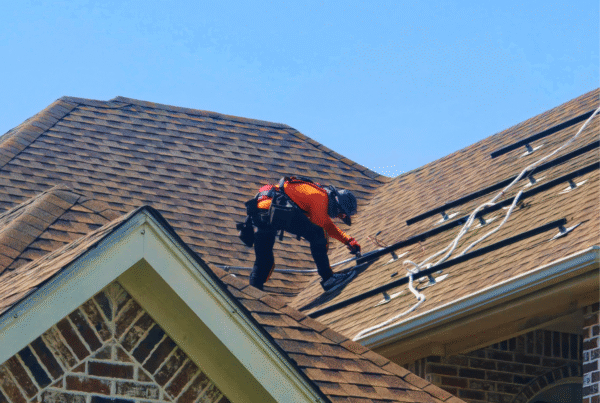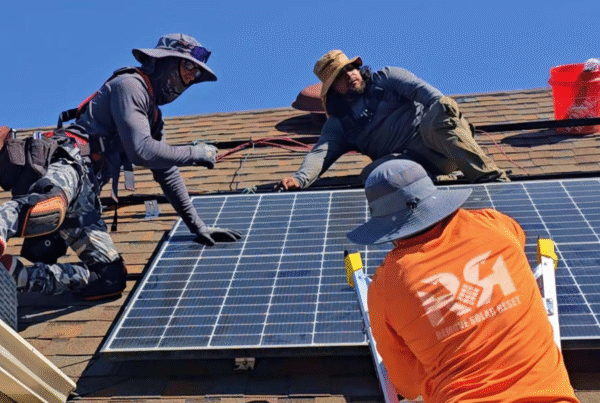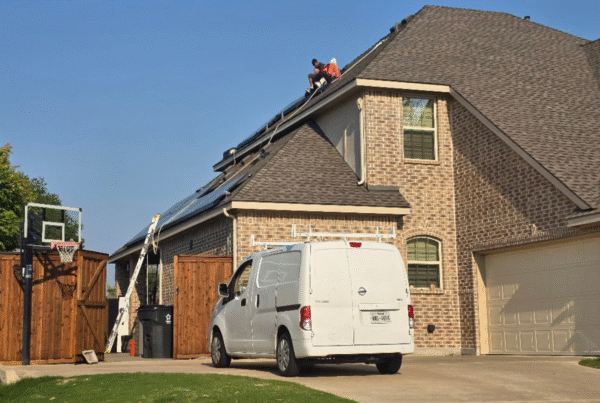Understanding Resale Value of Unused Solar Equipment in Texas for Homeowners and Contractors
Updated: October 2025
For homeowners searching for what is the resale value of unused solar equipment near me in Texas, understanding market pricing is crucial before selling or relocating panels. Unused solar equipment can retain significant value, but several factors affect resale price, including equipment age, brand, and condition.
As of October 2025, Texas’s used solar market pricing reflects growing demand driven by an increase in system upgrades and replacements. Selling unused solar panels through certified professionals ensures you maximize your return while complying with local standards.
If you’re ready to sell unused solar panels or need expert help with removal and reinstallation, contact our certified team. Fast, safe, and comprehensive services protect your investment every step of the way. Call 469-283-1089 or request a free quote today.
Quick Answer
The resale value of unused solar equipment in Texas typically ranges between 40-70% of the original purchase price, depending on brand, age, and condition. Quality components retain higher resale prices, especially Tesla, Enphase, and SolarEdge brands. Certified removal and documentation increase buyer confidence and maximize resale offers.
Factors Affecting Resale Value of Solar Equipment in Texas
The resale value of unused solar equipment depends on multiple factors. These include the brand and model, with premium brands like Tesla, Enphase, and SolarEdge commanding higher resale prices. System age and warranty status also play key roles; newer systems with transferable warranties fetch better offers.
Condition is critical. Panels, inverters, and mounting hardware free from damage or weather wear sell at premium prices. Proper documentation and professional removal increase buyer confidence, leading to better market pricing.
Recent industry updates in October 2025 highlight that buyers now prefer equipment removed by certified technicians due to structural integrity and safety assessments, emphasizing the benefit of professional services.
Current Resale Price Ranges of Solar Components in Texas Used Market
Based on 2025 industry data, resale prices for unused solar components typically fall between 40% and 70% of original costs. Panels in excellent condition with warranty can achieve the higher end, while older or cosmetic damaged equipment might fetch less.
| Solar Equipment Type | Typical Resale Price Range | Condition Impact |
|---|---|---|
| Solar Panels (Tesla, Enphase) | $100-$250 per panel | High if undamaged & warranty valid |
| Inverters & Optimizers | $500-$1,200 each | Condition and model crucial |
| Mounting Hardware & Racking | 30%-50% of original cost | Minimal wear preferred |
These figures vary widely with market demand and local Texas conditions. Documentation from professional removal also impacts resale price.
These are approximate resale prices; contact us for a free estimate specific to your project.
Ready to protect your investment with certified removal? Call (469) 283-1089 for a free estimate tailored to your Texas project.
Options to Sell Unused Solar Panels Near Me in Texas
Selling unused solar panels locally includes options such as private buyers, solar equipment resellers, and recycling centers. Private sales often yield higher resale prices but require professional removal and detailed documentation.
Some Texas-based solar companies buy back unused panels under certain conditions. Certified removal and inspection reports improve buyer trust and resale price.
Consulting experts helps you navigate local used solar market pricing and ensures compliance with state laws.
Common Removal Mistakes to Avoid When Selling Solar Equipment
DIY removal risks damaging panels or roof, voiding warranties and reducing resale value. Mishandling electrical components leads to safety hazards and further devaluation.
Incomplete or missing documentation can lower offers significantly, as buyers seek proof of condition and safe removal. Unlicensed removal may violate Texas construction and electrical codes.
Professional services avoid these pitfalls, preserving resale price and insurance coverage.
Step-by-Step Safe Solar Panel Removal Process (Case Study Included)
Our typical removal process in Texas includes:
- Initial site inspection and documentation
- Scheduling utility disconnection
- Roof safety setup with fall arrest systems
- Careful disconnection of electrical components
- Panel detachment using specialized tools
- Packing and secure storage or relocation
- Final 42-point inspection
- Full project documentation for insurance or warranty claims
In a recent Dallas project, we removed 24 panels during a 2-day roof replacement, preserving warranty and roof integrity throughout. Documentation helped the homeowner recoup over 60% of original equipment cost through resale.
Why Choose Remove Solar Reset for Your Solar Equipment Project
Remove Solar Reset offers 9+ years of Texas solar expertise, led by Fernando Alegre, Master Electrician with Tesla, Enphase, and SolarEdge certifications. We maintain full liability and workers’ compensation insurance, adhering to all OSHA safety standards.
Our team completes solar panel removal 60% faster than industry average while achieving a 99.8% warranty retention rate across 500+ projects. With zero roof damage claims in 2025 and a 10-year leak protection warranty, clients trust us for complex and urgent jobs alike.
Learn more about our certified services here.
DIY vs Professional Solar Panel Removal in Texas: A Comparison
| Aspect | DIY Removal | Professional Removal |
|---|---|---|
| Safety | High risk; no fall or electrical protection | Full OSHA-compliant safety measures |
| Warranty Impact | High chance of voiding warranties | Warranty retention 99.8% |
| Time | Often several days or weeks | 4-6 hours for typical residential jobs |
| Documentation Provided | None | Full inspection and reports |
| Resale Value | Significantly reduced | Maximized resale price |
Cost & Insurance Considerations for Removing and Selling Unused Solar Equipment
Removal costs vary by system size and complexity but typically range from $2,000 to $5,000 for residential setups in Texas. Insurance often covers panel removal after storm damage if properly documented. Our team provides full documentation and works directly with insurance claim specialists.
| System Size | Removal Cost | Timeline |
|---|---|---|
| 10-15 panels | $2,000-$3,500 | 1 day |
| 16-25 panels | $3,500-$5,000 | 1-2 days |
These are approximate costs; contact us for a free estimate specific to your project.
Best Time to Remove and Sell Solar Equipment in Texas
Spring and fall offer optimal weather conditions for safe and efficient solar panel removal and resale. Avoid peak summer heat and winter storms to minimize risks and delays. Planning removal before roofing or system upgrades maximizes resale timing and buyer interest in Texas.
Texas Local Market Context for Selling Unused Solar Panels
Texas’s expanding solar market and frequent severe weather events have increased the volume of unused panel availability in recent years. Cities like Dallas, Houston, and Austin see high demand for quality used solar equipment.
Our solar panel removal near me in Texas services include storm damage cleanup, insurance claim support, and maintenance, addressing local climatic and regulatory challenges efficiently.
Frequently Asked Questions About Resale Value of Unused Solar Equipment
What is the average cost of removing solar panels?
Removal costs in Texas typically range from $2,000 to $5,000 for residential systems depending on size and roof complexity. This includes electrical disconnection, panel detachment, and safety equipment. Our licensed technicians provide transparent pricing and documentation. Contact us for a free estimate specific to your project.
How do I get solar panels removed?
Start by hiring licensed professionals for safe disconnection and removal. Our certified team schedules utility disconnects, secures roof safety, and performs panel removal documenting every step. Professional removal preserves warranty and maximizes resale value. Learn more on our process page.
How much for solar panel removal?
Texas removal costs are generally $2,000 to $5,000, varying with system size and roof type. Factors include panel count, electrical complexity, and safety requirements. Accurate estimates require inspection; call us to schedule a free consultation and precise quote.
How do I get rid of my old solar panels?
You can sell them through resellers or recycle responsibly. Professional removal and condition assessment increase resale opportunities. Recycle unusable panels via Texas-approved facilities. We provide removal, resale guidance, and recycling referrals.
Can I remove solar panels myself?
DIY removal is risky and can void warranties or damage your roof and equipment. It requires expertise in electrical safety and roof work. Professional removal increases resale value and protects insurance claims. Read about our licensed services here.
How long does it take to remove solar panels?
Professional solar panel removal typically takes 4-6 hours for residential systems with 10-20 panels. Larger or complex roofs may need a full day. Our certified teams complete removals 60% faster than average while ensuring zero roof damage.
Will removing solar panels damage my roof?
Improper removal can damage roofs and void warranties. Licensed professionals use fall protection and proper tools to avoid leaks or structural damage. Our 10-year leak protection warranty backs our expert removals.
How do you uninstall solar panels for roof replacement?
Disconnection, secure panel removal, roof replacement preparation, and reinstallation follow manufacturer standards. Our team documents every step ensuring warranty protection. Visit our roof replacement with solar R&R guide for details.
Can old solar panels be recycled?
Yes, end-of-life panels are recyclable. Texas has specialized facilities handling solar component recycling. Responsible recycling reduces landfill waste and recovers valuable materials. We coordinate panel removal and recycling logistics.
Does insurance cover solar panel removal after storm damage?
Many policies cover storm-related removal if properly documented. Our team supports insurance claims with detailed inspection and removal reports. Check your policy and get expert help to optimize your claim.
What certifications should a solar removal company have?
Look for Master Electrician licensure and certifications from Tesla, Enphase, or SolarEdge. Full insurance, OSHA compliance, and proven experience in complex projects are critical. We hold all these credentials for Texas homeowners.
Is removing solar panels dangerous?
Yes, it involves electrical and fall hazards requiring trained personnel and safety measures. Licensed technicians follow OSHA 1926.501 fall protection standards ensuring safe, compliant removal in Texas.
Do solar removal services include reinstallation?
Many professional companies offer removal and reinstallation. We specialize in solar panel removal & reinstallation, diagnostics, and maintenance ensuring seamless service and warranty compliance. Learn more here.
Can I sell used solar panels after removing?
Yes, unused panels retain resale value if in good condition and properly removed. Certified removal increases buyer confidence. Texas offers a growing used solar market with resellers and private buyers.
How do I document solar panel removal for insurance claims?
Comprehensive reports including photos, 42-point inspections, and detailed work logs support claims. Our licensed team provides full documentation for Texas insurance specialists ensuring smooth claim processing.
How much does it cost to remove and reinstall solar panels for a new roof?
Costs typically range from $4,000 to $8,000 combining removal and reinstallation, varying by system size and roof complexity. Professional service protects warranties and insurance coverage. Contact us for a tailored quote.
What happens if I don’t remove solar panels before roof replacement?
Panels not removed can be damaged, voiding warranties and risking water leaks. Roofing contractor delays are common. Certified removal protects system and roof, avoiding costly repairs.
Do I need a permit to remove solar panels in Texas?
Permits vary by city and type of removal. Licensed professionals ensure compliance with local regulations. We assist with necessary permits for hassle-free project completion.
How do I find a licensed solar removal company near me?
Search local Texas companies with Master Electrician licenses and Tesla/Enphase/SolarEdge certifications. Check reviews and inquire about insurance. Contact Remove Solar Reset for trusted, licensed solar panel removal near me in Texas.
Can solar panels be removed in winter/summer?
Yes, panels can be removed year-round. However, extreme heat or storms may affect safety and scheduling. Spring and fall are preferred for Texas projects.
Related Resources & Guides
Explore these related articles to learn more about solar panel services in Texas:
- Five Essential Tips for Replacing Your Roof with Solar Panels — Expert advice to coordinate roofing and solar removal in Texas.
- Four Essential Tips for Reroofing Your Home with Solar Panels — How to plan reroof projects efficiently with solar systems.
- Why Choose Remove Solar Reset — Discover our certified team benefits and insurance coverage.
- Frequently Asked Questions — Answers to common solar panel removal and maintenance queries.
Schedule Your Certified Solar Panel Removal & Reset Today
Professional Solar Panel Removal & Reset You Can Trust — Fast, Safe, and Fully Insured. Protect your warranty and avoid costly roof damage. Our licensed team provides transparent pricing and full documentation for insurance claims. Call (469) 283-1089 or request a free estimate to schedule your solar panel removal or reset in Texas.
Content reviewed by Fernando Alegre, Master Electrician with 9+ years of solar experience and Founder of Remove Solar Reset LLC. Certified by Tesla, Enphase, and SolarEdge. Technical sources: U.S. Department of Energy (energy.gov), OSHA safety standards (osha.gov), and manufacturer warranty guidelines.






